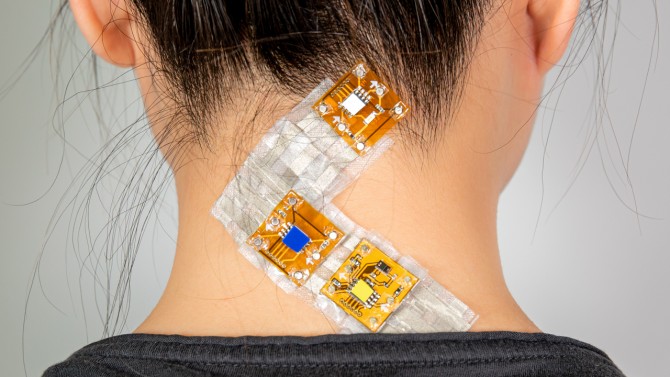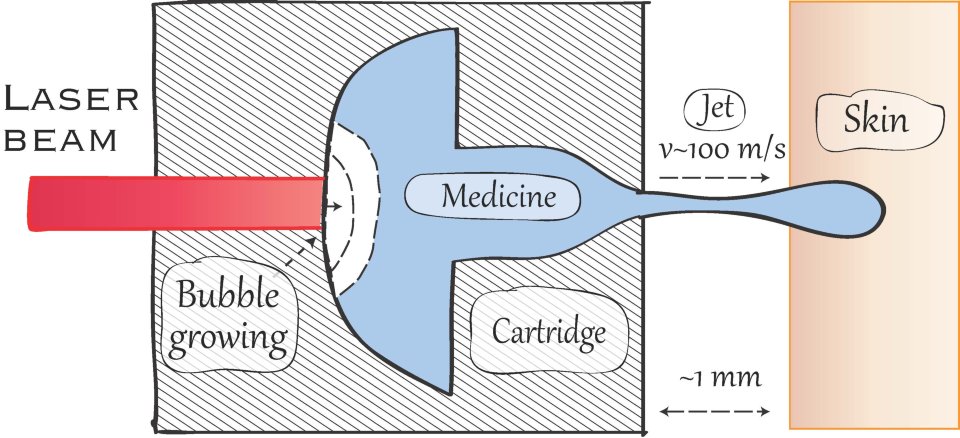
A November 3, 2022 Cornell University news release on EurekAlert announces a computer you can attach to your skin (Note: Links have been removed),
Researchers at Cornell University have come up with a reliable, skin-tight computing system that’s easy to attach and detach, and can be used for a variety of purposes – from health monitoring to fashion.
On-skin interfaces – sometimes known as “smart tattoos” – have the potential to outperform the sensing capabilities of current wearable technologies but combining comfort and durability has proven challenging.
“We’ve been working on this for years,” said Cindy (Hsin-Liu) Kao, assistant professor of human centered design, and the study’s senior author, “and I think we’ve finally figured out a lot of the technical challenges. We wanted to create a modular approach to smart tattoos, to make them as straightforward as building Legos.”
SkinKit – a plug-and-play system that aims to “lower the floor for entry” to on-skin interfaces for those with little or no technical expertise – is the product of countless hours of development, testing and redevelopment, Kao said. Fabrication is done with temporary tattoo paper, silicone textile stabilizer and water, creating a multi-layer thin film structure they call “skin cloth.” The layered material can be cut into desired shapes and fitted with electronics hardware to perform a range of tasks.
“The wearer can easily attach them together and also detach them,” said Pin-Sung Ku, lead author of the paper and Hybrid Body Lab member. “Let’s say that today you want to use one of the sensors for certain purposes, but tomorrow you want it for something different. You can easily just detach them and reuse some of the modules to make a new device in minutes.”
The paper “SkinKit: Construction Kit for On-Skin Interface Prototyping” was presented at UbiComp ’22, the Association for Computing Machinery’s international joint conference on pervasive and ubiquitous computing.
Here’s a SkinKit video provided by Cornell University’s Hybrid Body Lab,
Tom Fleischman’s November 3, 2022 story for the Cornell Chronicle provides more details about SkinKit (Note: Links have been removed),
SkinKit – a plug-and-play system that aims to “lower the floor for entry” to on-skin interfaces, Kao said, for those with little or no technical expertise – is the product of countless hours of development, testing and redevelopment, she said.
Kao’s lab is also very conscious of cultural differences generally, and she thinks it’s important to bring these devices to diverse populations.
“People from different cultures, backgrounds and ethnicities can have very different perceptions toward these devices,” she said. “We felt it’s actually very important to let more people have a voice in saying what they want these smart tattoos to do.”
…
To test SkinKit, the researchers first recruited nine participants with both STEM and design backgrounds to build and wear the devices. Their input from the 90-minute workshop helped inform further modifications, which the group performed before conducting a larger, two-day study involving 25 participants with both STEM and design backgrounds.
Devices designed by the 25 study participants addressed: health and wellness, including temperature sensors to detect fever due to COVID-19; personal safety, including a device that would help the wearer maintain social distance during the pandemic; notification, including an arm-worn device that a runner could wear that would vibrate when a vehicle was near; and assistive technology, such as a wrist-worn sensor for the blind that would vibrate when the wearer was about to bump into an object.
…
Kao said members of her lab, including Ku, took part in the 4-H Career Explorations Conference over the summer, and had approximately 10 middle-schoolers from upstate New York build their own SkinKit devices.
“I think it just shows us a lot of potential for STEM [science, technology, engineering, and mathematics] learning, and especially to be able to engage people who maybe originally wouldn’t have interest in STEM,” Kao said. “But by combining it with body art and fashion, I think there’s a lot of potential for it to engage the next generation and broader populations to explore the future of smart tattoos.”
…
Here’s a citation for the paper,
“SkinKit: Construction Kit for On-Skin Interface Prototyping” by Pin-Sung Ku, Md. Tahmidul Islam Molla, Kunpeng Huang, Priya Kattappurath, Krithik Ranjan, Hsin-Liu Cindy Kao. Proceedings of the ACM [Aossciation for Computing Machinery] on Interactive, Mobile, Wearable and Ubiquitous Technologies Volume 5 Issue 4 Dec 2021 Article No.: 165pp 1–23 DOI: https://doi.org/10.1145/3494989 Published: 30 December 2021
This paper is behind a paywall.
The Hybrid Body Lab can be found here (the pictures are fascinating). Here’s more from their About page,
The Hybrid Body Lab at Cornell University, founded and directed by Prof. Cindy Hsin-Liu Kao, focuses on the invention of culturally-inspired materials, processes, and tools for crafting technology on the body surface. Designing across scales, we explore how body scale interfaces can enhance our relations with everyday products and both natural and man-made environments. We conduct research at the intersection of Human-Computer Interaction, Wearable & Ubiquitous Computing, Digital Fabrication, Interaction Design, and Fashion & Body Art. We synthesize this knowledge to contribute a culturally-sensitive lens to the future of designs that interface the body and the environment. Our current investigations include:
Wearable Technology & On-Skin Interfaces
We develop novel wearable interfaces and fabrication processes, which a focus on skin-conformable or textile-based form factors. By hybridizing miniaturized robotics, machines, and materials with cultural body decoration practices, we investigate how technology can be situated as a culturally meaningful material for crafting our identities.Designing Skins Across Scales
‘Many different types of machines that were parts of architecture have become parts of our bodies.’ —Bill Mitchell, Me++We design “skins” that can be adapted across scales, from the architectural to the body scale. We investigate the interactions of a wearer’s body-borne interface with its surrounding ecology. This includes its interaction with other people, objects, to environments. We are also interested in developing skins that can be deployed across scales — from the body to the architectural scale.
Understanding Social Perceptions Towards On-Body Technologies
Wearable devices have evolved towards intrinsic human augmentation, unlocking the human skin as an interface for seamless interaction. However, the non-traditional form factor of these on-skin interfaces may raise concerns for public wear. These perceptions will influence whether a new form of technology will eventually be accepted, or rejected by society. We investigate the cultural and social concerns that need to be considered when generating on-body technologies for inclusive design.
